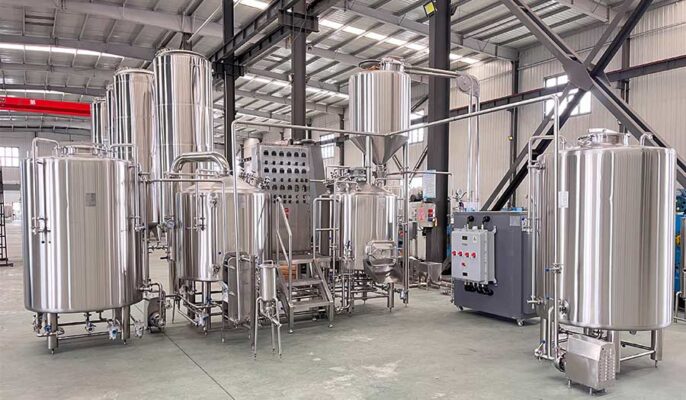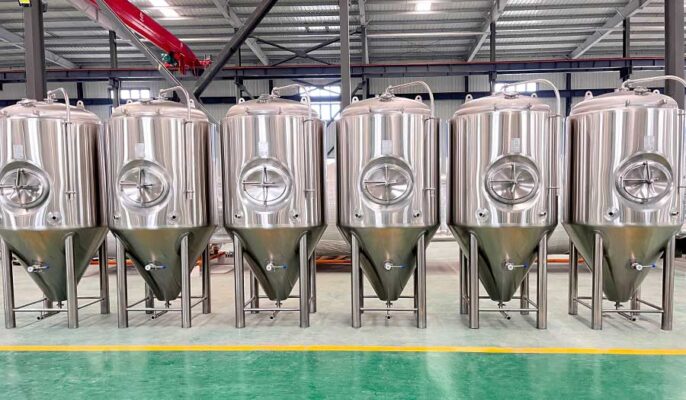Small batch brewing equipment dominates the brewing industry. Unlike commercial brewing, small batch beer offers a hands-on approach to production. Each step of the process can be customized to suit individual tastes. In this guide, we’ll explore together how to choose small-batch brewing equipment and the brewing process, among other things.
What is small batch brewing?
Small-batch brewing is when a smaller amount of beer is brewed compared to a commercial brewery. It typically brews about 1 to 5 gallons of beer. This smaller size allows for better control of the brewing process and allows the brewer to experiment with unique ingredients and flavors.
Small-batch brewing is not only a way to create personalized and unique beers, but it also provides a more practical approach to the brewing process. With smaller equipment and volume, brewers can observe and adjust each step, allowing for a deeper understanding of brewing techniques and their impact on the final product.
Small Batch Brewing Processes
- Mash: this process activates enzymes in the malt that convert starch into fermentable sugars, producing a sweet liquid called wort.
- Boiling: this is the stage where you must boil the wort and add hops at various intervals. This process also sanitizes the wort, stopping enzyme activity and precipitating proteins that can cloud the beer.
- 発酵: This stage converts the sugary wort into beer, producing alcohol and carbon dioxide as well as flavor compounds such as esters and phenols. Depending on the type of beer, fermentation can take anywhere from a few days to a few weeks.
- Secondary Fermentation: this is the stage where flavors mature. To achieve natural carbonation, you can add trigger sugars before bottling or force carbonation in the keg.
Each step in the brewing process provides the brewer with the opportunity to tweak and experiment, which affects the final beer’s taste, aroma, body, and clarity.

Small Batch Brewing Equipment
ブリューケトル
One of the main pieces of equipment needed to brew small-batch beer is a brew kettle. These containers are specifically designed to boil the ingredients and impart flavor to the beer. Brew kettles come in a variety of sizes and materials, such as stainless steel and aluminum. They usually come with handles, faucets, and lids to facilitate the brewing process.
発酵槽
After boiling the wort in the brew kettle, it’s time to transfer it to the fermentation vessel and let the yeast work its magic. Large glass carboys and plastic buckets are the most common types of fermentation vessels used in small-batch brewing. Large glass carboys are usually made of glass or plastic and allow you to visually monitor the fermentation process. Plastic buckets are affordable and easy to clean, making them a popular choice for home brewers.
ボトリング設備
Once the beer has fermented and undergone any secondary processing, it is ready to be bottled and consumed. Bottling equipment includes bottling machines, cappers, and bottle brushes. Bottling machines make the bottling process more efficient by minimizing spills and ensuring consistent fill levels. Cappers securely seal bottles, while bottle brushes help clean and sanitize bottles before filling.
How to Choose Small Batch Brewing Equipment?
生産量
When choosing brewing equipment, an essential consideration is determining production volume. State clearly how much beer you intend to brew in a specific time frame. This decision should consider market demand, distribution channels, and realistic growth projections. Knowing your target production volume will guide you in selecting equipment that can effectively achieve your production goals.
|
醸造設備 |
定員 |
バッチサイズ |
|
1-Gallon System |
1 gallon (3.8 liters) |
Approximately 10 to 12 bottles (12 oz each) |
|
5-Gallon System |
5 gallons (18.9 liters) |
Approximately 48 to 52 bottles (12 oz each) |
|
10-Gallon System |
10 gallons (37.8 liters) |
Approximately 96 to 100 bottles (12 oz each) |
素材の選択
- Stainless Steel Brewing Equipment: Stainless steel brewing equipment is a popular choice for home brewers. First, stainless steel is very durable and rust-resistant, making it a long-term choice for your brewing needs. The material is also less porous than plastic, reducing the risk of bacteria growth or giving your beer an off-flavor.
- Plastic Brewing Equipment: Plastic brewing equipment is typically made from food-grade high-density polyethylene (HDPE), which offers a range of advantages. One of the main advantages is that it is affordable, making it an affordable option for those just starting to brew beer. However, it is important to note that plastic is more susceptible to scratches and degradation over time, which can breed bacteria and may affect the taste and quality of your beer.
|
素材 |
長所 |
短所 |
|
ステンレス鋼 |
Durable and resistant to rust |
Higher price |
|
プラスチック |
Affordable |
More susceptible to scratches and degradation |
Brewing Process and Batch Size
Evaluate your brewing process and determine the typical batch size you plan to produce. Whether you focus on a small batch process or larger batches, your equipment selection should align with your brewing style, recipe complexity, and the number of fermenters and storage vessels required. Your brewing equipment should seamlessly adapt to your desired batch size.
Budget and Financial Considerations
Understand your budget constraints and financial goals when choosing brewing equipment. While cost is an important factor, balance your budget with the long-term value and performance of your equipment. Consider factors such as equipment life, warranty, maintenance costs, and potential return on investment to make an informed decision.
ユーティリティ要件
Evaluate the utility requirements for your brewing equipment, including specifications for electricity, water, and gas supply. Make sure your facility can meet these requirements to support the selected equipment. Consulting with utility providers and equipment manufacturers can help you determine the exact specifications needed for seamless integration.
Brand Reputation and Reviews
When investing in small-batch brewing equipment, knowing the trusted brands can make a big difference in your brewing experience. Researching brewing equipment brands and reading customer reviews are important steps in assessing the quality and reliability of the products you are considering. By taking the time to gather information and insights from other brewers, you can make an informed decision and find equipment that meets your needs.

よくある質問
How do I fix stagnant fermentation?
酵母が早期に動きを止め、ビールの発酵が不足し、発酵が停滞する。この問題を解決するには、ピッチング速度が適切であることを確認し、必要であれば酵母を静かに移動させるか、新鮮な酵母培養物の導入を検討する。
What types of small-batch brewing equipment are available?
醸造ポット、発酵槽、瓶詰め装置など、少量生産の醸造設備にはいくつかの種類があります。それぞれのタイプには利点と注意点があります。様々な選択肢を理解することで、十分な情報を得た上で決断し、自分の醸造スタイルに合った機器を選ぶことができます。
How should I establish a budget for my brewing equipment?
醸造器具の予算設定は、あなたの状況や醸造の目標によって異なります。趣味へのこだわり、必要な器具の品質、長期的な投資計画などを考慮する必要があります。手頃な価格と品質の間でバランスを取ることが重要であり、それに見合ったものを確実に手に入れることができる。
What batches can small-batch brewing equipment accommodate?
少量生産の醸造設備には、様々なバッチサイズに対応できるよう、様々なサイズがあります。購入する前に、醸造の要件を評価し、製造したいビールの量を決定します。そうすることで、醸造品質を落とすことなく、希望のバッチサイズに対応できる機器を選ぶことができます。
What material should I consider using for my brewing equipment?
醸造器具の材質はビールの品質と耐久性に影響します。一般的な素材にはステンレスとプラスチックがあります。ステンレス製は強度があり、錆びにくく、洗浄が簡単なことで知られていますが、プラスチック製は軽量で、価格も手頃です。素材を選ぶ際には、醸造の好みと長期的な目標を考慮してください。




